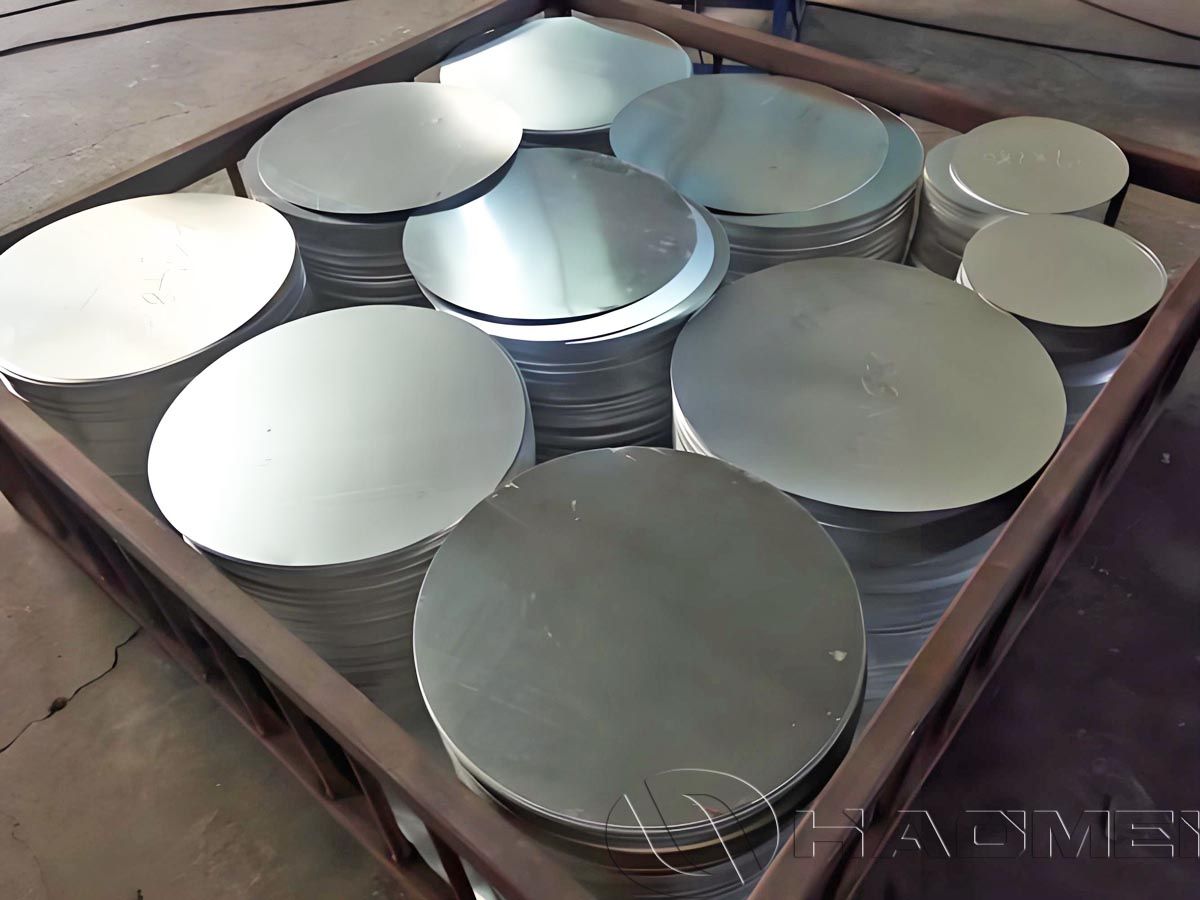
 No.14 Waihuan Road, CBD, Zhengzhou, China
No.14 Waihuan Road, CBD, Zhengzhou, China
 +86-18703635966
+86-18703635966

 No.14 Waihuan Road, CBD, Zhengzhou, China
No.14 Waihuan Road, CBD, Zhengzhou, China
 +86-18703635966
+86-18703635966
3003 aluminum alloy belongs to the aluminum-manganese (Al-Mn) series, with aluminum (Al) content over 96%, and small amounts of manganese (Mn) and copper (Cu). It features excellent corrosion resistance and formability. Compared with the 1000 series of pure aluminum, 3003 aluminum alloy has higher strength while maintaining good machinability, making it highly suitable for deep drawing, stretching, and rolling processes.
The most common 12-inch 3003 aluminum circles are produced by stamping and drawing 3003 aluminum sheets or coils into circular shapes with a diameter of approximately 30.48 cm (12 inches). They are widely used in cookware manufacturing, industrial components, and decorative panels.
12 inches is a market-proven efficient size.
Cookware industry: Ideal for manufacturing medium-to-large pots, soup pots, and frying pans after drawing, offering high material utilization and reducing scrap rates.
Traffic signage industry: Suitable for medium and small road signs, interior indicators, or as modular units for larger signs.

Lightweight Design: Lighter than steel, reducing transportation and processing costs.
Moderate Strength: Approximately 20% stronger than pure aluminum (1050/1060 series), sufficient for most cookware and container structural stability requirements.
Excellent Weldability: Compatible with TIG, MIG, and other welding methods, convenient for assembling with other components.
Outstanding Deep Drawing Performance: In the O temper (annealed state), 3003 aluminum exhibits excellent plasticity, easily forming deep pots, kettle bodies, and other products without cracking or wrinkling.
Superior Corrosion Resistance: Forms a dense oxide film on the surface, providing excellent rust resistance and protection against moisture, acidic or alkaline food, and outdoor environments.
Good Surface Finish: Smooth and flat surface, suitable for polishing, painting, anodizing, or applying reflective films. For cookware, it adheres well to non-stick coatings; for signs, it provides a flat base for reflective sheeting.
| Material | 3003 aluminum alloy |
| Temper | O, H14, H18, H24, etc. |
| Diameter | 12 inches (≈30.48 cm) |
| Thickness | 0.3 mm - 3.0 mm (customizable) |
| Surface Condition | Bright or matte |
| Color | Silver / pre-coated color (optional) |
| Production Process | Rolling + drawing/deep drawing + annealing |
| Packaging | Cardboard or wooden boxes for protection against transport scratches |
| MOQ | 1-3 tons |
Mechanical Properties
| Property | O | H14 | H24 |
| Tensile Strength (MPa) | 110 | 150 | 170 |
| Yield Strength (MPa) | 40 | 130 | 140 |
| Elongation (%) | ≥20 | ≥5 | ≥8 |
Cookware Manufacturing: Non-stick pan bottoms, pressure cooker liners, steamers, and multi-functional pot bases.
Construction & Decoration: Aluminum ceiling panels, decorative circles, exterior wall panels.
Industrial Components: Industrial reflectors, instrument housings, fan blades, or radiator chassis.
Traffic Signage: Road signs and reflective boards.
Casting & Homogenization: Strict control of alloy composition, with homogenization treatment to eliminate segregation.
Hot/Cold Rolling: Aluminum ingots are rolled into sheets or coils of the required thickness.
Annealing (O Temper): For deep drawing applications, annealing softens the material and restores plasticity, which is key to successful circle forming.
Precision Stamping: Using high-precision dies, 12-inch aluminum circles are punched from the aluminum coil or sheet.
Surface Treatment & Packaging: The surface is cleaned, free from oil and scratches, and packaged in moisture-proof protective materials.

1. Chemical Composition & Food Safety
Standards Compliance: Chemical composition strictly conforms to ASTM B209, EN 573, or GB/T 3190.
Heavy Metal Control: For cookware applications, strict testing and control of lead, cadmium, arsenic, and other heavy metals, complying with FDA, LFGB, and other food-contact material standards.
2. Critical Tolerances
Thickness Tolerance: Strictly controlled within ±0.02 mm or less to ensure stable feeding in deep drawing molds.
Diameter Tolerance: Precisely controlled within ±0.5 mm to ensure compatibility with automated production lines.
3. Surface Quality
Flatness: Smooth and flat, free of waves, creases, or depressions.
Cleanliness: Free of oil, oxidation, or dust, ensuring optimal adhesion for non-stick coatings or anodized layers.
Defect Control: No deep scratches, dents, bubbles, or pinholes visible to the naked eye, preventing defects after coating or drawing.
4. Mechanical Properties & Formability
Elongation: For O temper circles, elongation must meet high specified values to ensure excellent deep drawing performance.
Tensile Strength: Maintained within specified range to ensure finished cookware rigidity.
Erichsen Test (Cup Test): Each batch is tested (usually ≥9.0 mm) to assess the material's deep drawing limit and plasticity.
Grain Size: Controlled within an appropriate range; grains too large or small negatively affect deep drawing performance and edge curling during forming.
Copyright © 2025 By HAOMEI Aluminum CO., LTD. All Rights Reserved. Sitemap